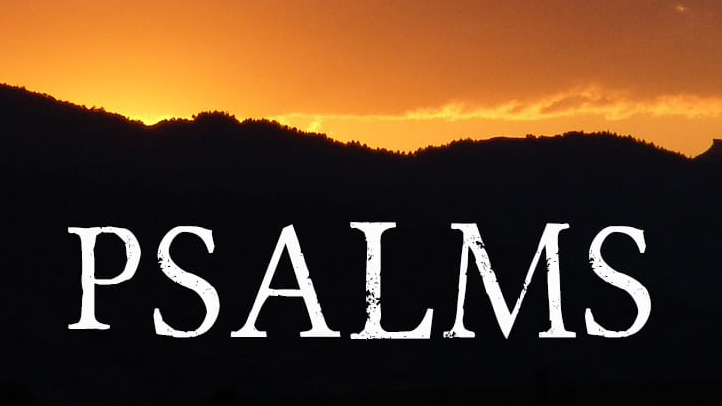A Divine Ensemble: Revisiting the Psalms from the Pulpit
by Rev. James Woods on Monday, January 8, 2018

Let us come into his presence with thanksgiving;
let us make a joyful noise to him with songs of praise! —Ps 92.2
Recently I’ve spent a lot of time thinking about the Psalms. During the first week of October, I traveled to a Trappist-Cistercian monastery in southcentral Missouri and participated in the monastic community there for six days. The central feature of Cistercian spirituality is the Divine Office, or Liturgy of the Hours, where the monks gather seven times throughout the day to worship through prayer. Chanting the Psalter is the focal point of that liturgy. Since my return home, I’ve maintained the (partial) discipline of praying the hours, making it a point to follow the schedule three times daily. That practice brought me to a stark realization: very rarely are the Psalms incorporated into our local worship. More specifically, very seldom do I hear the Psalms preached. There are two major reasons I see that omission is a missed opportunity.
In reflecting on the Psalms, theologian Walter Brueggemann notes that they are “filled with metaphors,” constructs that require an intense imagination to unlock their full spiritual potential.”[1] When we preach the psalms, we present the congregation with an opportunity to open depth of meaning to their lives, creating dynamic equivalence between the ancient hymnody and their contemporary experience. For example, Psalm 13:2b sees the psalmist crying, “How long shall my enemy be exalted over me?” This single verse is multivalent, and we as preachers have the occasion and obligation to help congregants map their “enemies” onto the text—figurative adversaries of illness, loneliness, or fear; or even embodied individuals or groups perceived as actual foes. Texts like this one open the door to the psalmist’s plight, enabling the community to express their experiences through the words of Scripture. And in the end, we help them understand, like the psalmist, that resolution—indeed the point all along—comes not by a focus on the “enemy,” but through trusting in God’s steadfast love and rejoicing in Divine salvation (Ps 13.5). Seen this way, the psalms become spiritual wormholes through which the congregation can be transported to alternate locations in the universe of worship, destinations that elicit a profound experience of God. The collective experiential milieu provides a harmonic within which the entire community is situated.
A second reason to take advantage of the opportunity to preaching the psalms is the antiphonal rhythm they evoke between the pastor and the congregation. Many churches no longer include the full complement of lectionary selections in their scriptural readings, and especially absent is the responsorial pattern of the psalms as in the Roman Catholic tradition. Nevertheless, we can create the spirit of that same back-and-forth flow through homiletic use of the Psalter. For selections like Psalm 136, the repetition of “for his steadfast love endures forever” is an obvious indicator of the give and take setting simply walking through the text generates. As the preacher speaks of the glory of God that the psalmist delights in, the resounding theme of God’s enduring love becomes a cradle that rocks the congregation with a steady, soothing pulse. However, literary format aside, any psalm can have this same consoling effect.
As we know, the Psalter is a collection of praises, laments, thanksgivings and wisdom; all of life’s stations are located somewhere within its one hundred and fifty entries. They speak to us through their metaphorical nature because we have all experienced their underlying truths. But while they invoke individual experiences and expressions of our personal realities, these realisms are only instances of the larger communal narrative we communicate together. This larger milieu includes the parishioners and the pastor. Homiletics professor Luke Powery reminds us that we “preach witheach other and not for one another” (my emphasis).[2] As such, the pastor’s verbal instrumentation of the psalms provides the melody to which the congregation transcribes the lyrics of life’s songs. Together, preacher and assembly form an antiphonal chorus of spiritual sound and mystical meter—fully aligned with the original purpose for and use of the psalms.
Since biblical times, the Psalter has always epitomized the songbook for the people. Its ideas and expressions are equally applicable today. Though some churches have changed or even removed its use in the weekly liturgy, the pulpit affords an opportunity to restore its life-affirming qualities. And we shouldn’t shy away from this opening; the Psalms are a natural format for our craft. Quoting author Kirk Jones, Powery provides the implicit linkage between song and preaching: “Musicians play notes; preachers play words.”[3] The church is the perfect venue for a divine ensemble.
Rev. James Woods is an Associate Pastor at First United Methodist Church McKinney.
[1] Walter Brueggemann, Praying the Psalms: Engaging Scripture and the Life of the Spirit (Eugene, OR: Cascade Books, 2007), 26-7.
[2] Luke A. Powery, Dem Dry Bones: Preaching, Death, and Hope (Minneapolis: Fortress Press, 2012), 29.
[3] Ibid, 25.
Image by nowayGR https://www.freeimages.com/photo/sunset-in-agios-kosmas-grevena-1638030
